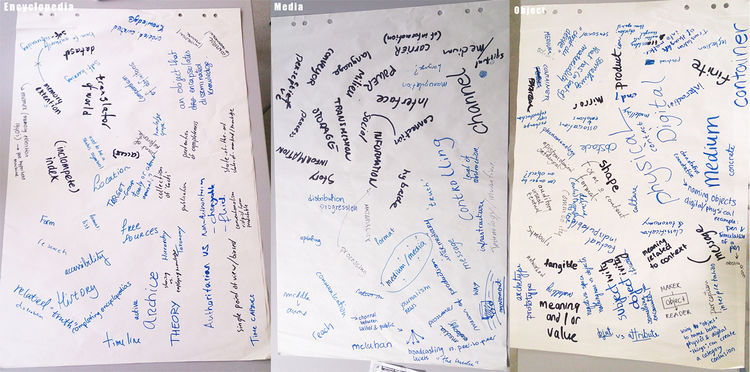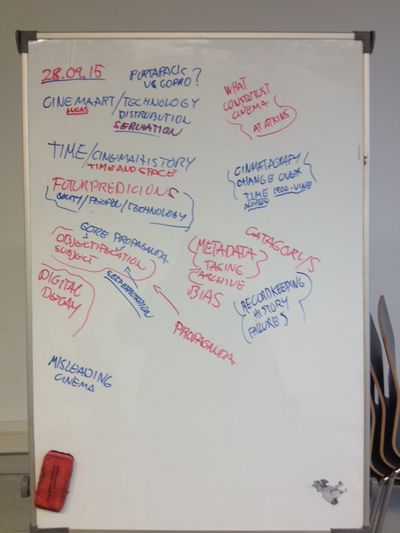EYE On Art: Difference between revisions
No edit summary |
No edit summary |
||
| Line 145: | Line 145: | ||
[[File:Encyclopedia Media Object.JPG|750px]] | [[File:Encyclopedia Media Object.JPG|750px]] | ||
==== Benjamin ==== | |||
== Meeting Monday 28th == | == Meeting Monday 28th == | ||
Revision as of 15:41, 5 October 2015
This page is for collecting information and thoughts on the EYE On Art 2016 programme.
Team
Please add your name to the list if you're not there yet!
- Julie
- Christina
- Cihad
- Ally
- Solange
- Ruben
- Sarah
- Joana
- Lucas
- Thomas
- Arantxa (?)
- Samira
- Julia
- Natalie
- Benjamin (?)
- Yuzhen
- Stone
Stage 1: Themes/Questions/Topics/...
The idea is to first come to a collective theme/question/topic/description/... to form an umbrella for our works.
Please prepare for our next meeting by putting your ideas in the following list:
- Questions: What practices lie in the boundaries between cinema, art and digital technologies? What can be said about their interaction today? (lucas)
- Theme: Colour
- Theme: Time and space in cinema history , Future Prediction and/or view on the past true cinema.
- Question: what are the specifics that constitute film/cinema? What happens if we apply these to other things. (Ie. if film is about moving people, that what happens if a game emotes people?) Or what happens if we apply these specifics in an algorithmic manner?
- Cinematic emotions. Investigate how cinema (and maybe other media expressions) triggers emotions or set moods. See ie. Ed Atkins
Let's not over-analyse things:
Allyson (little Arantxa)
Objectification of the subject in cinema
Gore and obscenity
Propaganda
Degradation
Digitization
Self exploitation via technology
What is the role of exploitation in cinema / what is the propaganda value of self exploitation in cinema?
Lucas Proposal 1 ("The legacy of Expanded Cinema in the Age of ditigal networks" blah blah highbrow blah etc)
As we will be dealing with a (historical) archive in some ways, I think it may be useful to tap into some of the history of experimental cinema, especially on expanded cinema.
Proposal:
“The legacy of expanded cinema in digital culture.”
I propose to explore practices and works that lie at the boundaries of “traditional” cinema, art and (today’s) network culture.
This could be approached as “the legacy of expanded cinema” today.
Expanded cinema refers to a wide practice of moving-image art/films from the 1960s onwards (the term was first popularized by Gene Youngblood’s 1970 influential study on film and media art “Expanded Cinema”). Mainly refers to cinematic and film-based works that go beyond the two-dimensional single screen convention. The central motto for artists and filmmakers associated with expanded cinema is to have “an expanded concept of art”, where art does not have to conform to traditional categories.
Is "Expanded cinema" still a useful category today though? Does it refer to a "medium", in the sense usually understood? With the ubiquity of moving-image installations, and the inclusion of moving image components within larger and complex works, does it make sense to speak of expanded cinema today?
For this reason (these questions), works from the archive can be presented as historical precursors to current practices that go beyond traditional cinema and act in the intersection of digital, network culture, film and art.
questions: How to bring something new to the conversation of cinema / art / media / networked technology, etc?
A synesthetic cinematic spectacle, where the notions of conventional film language (narrative, structure, etc) are extended outside the single-screen space, and into:
- multiple projections,
- mixed media,
- complex film projects,
- live action / performance films,
- intermedia techniques
- audience participation
Things that can be included apart from moving-image based works:
- Printed ephemera
- Publications
- Flip-books
Lucas Proposal 2: Colour
Colour in moving-image
Moving Colour
The treatment of colour in art cinema.
The history of cinema is, of course, closely related with the advances in its technology. And perhaps this is most obvious in the use of colour in film art. It could be interesting to contrasts different approaches to colour in different times and technologies:
- film (16mm, etc. the practice of painting directly onto the filmstock)
- video (analogue tape and video signals)
- digital (digital film/animation, internet-based)
- moving-image installations (i.e. Olafur Eliasson, etc)
Since the advent of abstract painting within the historical avant-gardes, artists have experimented with abstraction and non-representational cinema. But only with colour techniques the use of abstraction was brought into a new level to a pair with experiments in painting at the time.
Approaches to colour in film have been very varied, from romantic, sublime considerations and themes (Stan Brakhage), to clinical and structuralist strategies (Malcom Le Grice, etc).
There might be plenty in the EYE archive to play with the range of these approaches. Though experiments in colour tend to take the form of abstract works and installations (it is probably easier then to tackle “pure” colour), we could also underscore the power of colour beyond abstract films works: examples in which a particular palette choice gives meaning to an image…
(any “four seasons” film come to mind?....)
We could use distinct areas of the gallery to have works with mainly different colours, like a predominantly blue area, etc.
(Although I’d rather concentrate on experimental film, video art, arthouse cinema and mixed works that disregard the division of traditional cinema and art, it could be useful to see the changes in cinematographic choices in narrative feature films – I mean, in “traditional” cinema. This might include consideration of the photographic palette in, for example, Kiewslovki’s Three Colours trilogy, Dereck Jarman’s Blue, Almodovar’s red settings, Peter Greenaway colours, etc … that is, films in which the colour plays an important part in the movie, in the narrative or by its meaning, or whatever. (yes I know, these examples are the usual suspects in modern/contemporary film … have to dig up more into the archive, although I’d rather this be a side thing…)
Some more keywords/etc by Lucas
- The EYE archive has a collection of film fragments, and we can use this, etc.
- But what is it about fragments? Can we say that an archive (an a history) is always fragmentary?
- Films of fragments / A fragmented film.
- How is the EYE archive organized? Maybe the EYE Institute has a classificatory system, with keywords, etc...
- We can look into the way te EYE archive is constructed, pick their keywords and present a programme based on their' classification....
Some keywords from Sol
Non-human, human, s-f, space, outer space, alien, imaginary, unimaginary, perception, hyperreality, believe, desire
Cihad
- Some of us were part of Thematic Seminar with Florian last year. We investigated media as an object.
- Maybe we can use some subjects from these notes or we can use this subject(object). Archive as an object? Film as an object?
- What kind of relation we have with film? with archive?
- film is non-human made by human
- What is the relation between human and film(non-human)
- What are the components of film? time, space, darkness, sound? How do they effect us? What is the future cinema? hyperreality?
Benjamin
Meeting Monday 28th
- Cinema art - Technology, Distribution, Circulation
- Time/Cinema History (Time and Space)
- Future Predictions (Society-People-Technology
- What Constitutes Cinema?
- Objectification of Subject (Gore,Propaganda,Self Exposure )
- Digital Decay
- Cinematography Change Over time
- Metadata, tackling archive , bias.. Failures of taging, errors
- Record keeping of the Archive
- Misleading Cinema
- Catagorys


